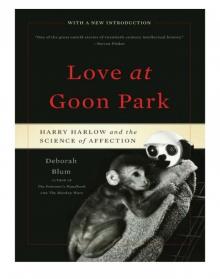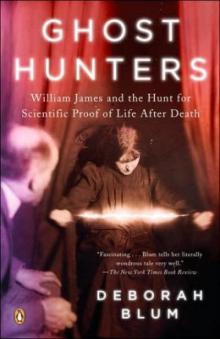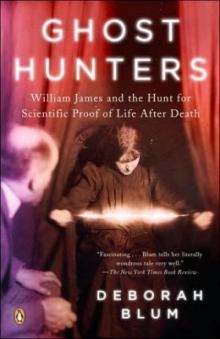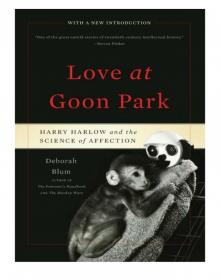- Home
- Deborah Blum
The Ghost Hunters Page 18
The Ghost Hunters Read online
Page 18
He was forty-one years old.
“ALAS! ALAS!”
On that Sunday, black and late on the day of discovery, Henry Sidgwick was sleepless with grief. He’d retreated into his study, lighting a single lamp, wrapping himself in the small pool of gold light. He sat by himself, writing in his diary, a private confessional of misery.
Fred Myers and his brother had brought “the terrible news” that afternoon. Arthur Myers, a physician, had gone to Brighton to identify the body, after police had found a letter addressed to him in Gurney’s pocket. After informing Gurney’s wife in London, he’d hurried to tell his brother, Fred, who’d collapsed into a numbed silence. The Myers brothers went together to tell the Sidgwicks. Fred Myers was still pale with shock and grief. He’d begged his weary brother to accompany him; he just didn’t think he could carry the news by himself.
“I can write no more journal this month,” Sidgwick wrote, alone in his quiet corner. “Fred Myers feels it terribly, but we too—Nora and I—do not know how we shall do without him.”
James still had that warm note of invitation from Gurney in his office. He could hardly believe the news. “It seems one of Death’s stupidest strokes,” he wrote to his brother, Henry. As a colleague in psychical research, James thought Gurney, if anyone, could have carried the field forward, helped it to achieve respect. “I know of no one whose life-task was begun on a more far-reaching scale or from whom one expected with greater certainty richer fruit in the ripeness of time.”
More, though, William James mourned a lost friend: “To me it will be a cruel loss, for he recognized me more than anyone, and in all my thoughts of returning to England, he was the Englishman from whom I awaited the most nourishing communion.”
The Brighton inquest concluded that the death had been an unfortunate accident—an inadvertent mishap resulting from Gurney’s regular use of chloroform to help him sleep. Sidgwick wanted to believe it.
Arthur Myers testified that he had known Gurney for nineteen years, both as a friend and as a physician. He’d treated Gurney for that reccurring neuralgic pain around his head and face. Gurney had been candid about his need to self-medicate. Dr. Myers had given him a number of prescriptions—morphine for sleep, sometimes chloral and belladonna for pain relief.
He knew that Gurney had also used the popular remedy chloroform to relieve neuralgia, traveling with it in case of an unexpected attack. Arthur Myers told the court that he was sure “Mr. Gurney had taken accidentally a larger dose than was his custom and had suffocated.”
Sidgwick sought comfort in that certainty. “One more line,” he wrote on June 29, returning compulsively to the secrecy of his diary. “I have just come back from the funeral. Arthur Myers, with whom I have had more than one talk, tells me that at the inquest on Monday there was a slight suggestion that it might be suicide; but it was easily and at once overborne by the evidence on the other side.”
Alone in his study he admitted to “painful doubts.” If his friend had been unhappy, wouldn’t he have taken note? Wouldn’t Nora have? “We saw him last on Tuesday 19th; he seemed to us well and in good spirits.”
“THEY SAY THERE is little doubt that Mr. Edmund Gurney committed suicide,” William James’s sister, Alice, then living in London, noted in her own diary.
Friends were now talking about Gurney’s mercurial nature, his tendency to drive himself to exhaustion, his unpredictable highs and lows. There were stories that he’d been driven to despair by psychical research, his morale destroyed by all the criticisms of his work. That he’d been demoralized by the amount of fraud they had encountered, such as the discovery of cheating by the Creery sisters; that he’d been depressed by the response to Phantasms of the Living. The editor of the British philosophy journal Mind told William James that he had worried that Gurney was taking his cause far too seriously, expressing concern about the “fury of this hunt after ghosts and the like, which is positively wasting him, the very body of him, I mean!”
There were slyer whispers, too, about his marriage. Kate Gurney had spent many hours without her husband’s company while the ghost hunt possessed him. All her friends knew that she’d felt abandoned by Gurney; now his friends began to wonder if he’d felt abandoned by his wife. As president of the SPR, Sidgwick sent Kate a formal sympathy letter in which his sorrow yet leaked through—“nothing that can be said in public will really express our sense of loss.” He promised her that they would continue with Gurney’s work, not only because it was important; they “owed it to the memory of our friend and colleague that the results of our previous labor should not fail for faint-heartedness.”
She answered their condolences politely; her warmest reply went to William James, who she thought the most “akin” of Gurney’s friends: “I have a strong certainty that he is happier & still achieving.... I feel that if I had never heard of the Immortality of the Soul—I should think he was going on.” But when the Society for Psychical Research established a memorial in his honor, the Edmund Gurney Library, she declined to contribute. And as soon as the socially required year’s mourning ended, she remarried. The following year, Henry James saw Kate Gurney at a smart little hotel in Paris. She was dressed in the latest style, the newer small bustle under her draped skirts, the little polished boots with their fancy buttons, the nicely tilted hat. She was no longer Kate Gurney, though; she’d married a politician and publicist, Archibald Grove.
The couple was stopping in Paris for a few days on their way to a vacation in Tangiers. “How the drama of life rushes on,” Henry wrote to William. “And how out of it all poor chloroformed Edmund Gurney seemed.”
CHARLES RICHET’S HANDS flew like startled birds when he was excited, which was much of the time. Slight and intensely energetic, with a thin face, high cheekbones, and an enormous, wonderfully drooping mustache, the Paris physiologist was infectious in all his enthusiasms: the immune system, a complicated treatment he was trying against tuberculosis, an analysis of the mechanisms of fever—and, more recently, a growing interest in psychical research. He’d collaborated with the SPR on several telepathy experiments, impressing the members with his thorough methods and exuberant friendliness.
With Edmund Gurney gone, approachable scientists such as Richet had become more valuable than ever in the psychical research movement. Their numbers were perilously small to start, and if the movement was to survive, the interest and friendship of such people must be cultivated. Sidgwick moved to strengthen the connection with Richet, seeking information about his work with hypnosis.
Although a Scottish physician had coined the word hypnosis, the British tended to regard the practice as the stuff of superstition and quackery. So, in general, did the American scientists. By contrast, French researchers approached hypnosis as a science, working from a theory that it could achieve a specific neurophysiologic state, an unusual suspension of most mental activity. Gurney, who had been an early admirer of Richet and his work, had considered the research gap as he mulled over a possible book on hypnosis. As he’d told James ruefully, “I don’t know how it is to be done. The French have all the material!”
In Paris, well-known physiologists Jean Charcot and Pierre Janet (the latter an associate of Richet) were using hypnosis to treat nervous system disorders, including epilepsy. Charcot believed that hypnosis tended to tranquilize the nervous system, creating what appeared to be a dreamlike trance. The French scientists could not agree on how to define the trance itself. Charcot and some of his colleagues, working from a strict physician’s point of view, felt that it indicated an abnormal mind, so that similar effects should not appear in the mentally healthy. Psychologists argued that, done well, hypnosis could induce a trance in anyone, that a hypnotic trance revealed the ability of one mind to impose its will on another. They pointed out that people with no evidence of mental defect had been and could be hypnotized. It was in studying the healthy, psychologists said, that the most interesting questions could be asked, such as why some minds appeared more s
uggestible than others.
As it pertained to psychical research, Richet considered another aspect of hypnosis. He wondered whether the trance state relaxed mental barriers, thus allowing one mind to become more open, more responsive to the thoughts of another. It occurred to him that a genuine medium might create her own internal hypnotic trance, that perhaps Mrs. Piper’s Phinuit was a personality produced by self-hypnosis.
Certainly, there was evidence linking the hypnotic state to telepathy, some of it from Gurney and Myers. Richet had also conducted earlier experiments, hypnotizing patients at a Paris mental hospital. He still remembered one adolescent girl who’d been sent there for treatment. One day Richet had brought an American medical student with him on a hospital tour. After Richet had hypnotized the girl, he said to her, “Do you know my friend’s name?”
Of course she didn’t. She began to laugh.
Let’s make it easier, he said; “Look, what is the first letter of his name?”
She lay in the narrow cot, silent, apparently asleep. He was ready to walk away when she replied, softly, “There are five letters; the first is H, then E ... I do not see the third, the fourth is R, and the fifth is N.”
The student’s last name was Hearn.
Richet calculated that the odds of the patient getting it right by chance were something like two hundred thousand to one.
Only recently, his colleague Pierre Janet had hypnotized a patient named “Leonie” and sent her “traveling” away from her secluded country home. Janet had been testing the idea that in a hypnotic trance, the human mind could float, balloonlike, drifting to the location that its owner wished to visit. Leonie announced that she was going to Paris to visit M. Richet.
Suddenly, her voice sharpened and rose. She said, “It is burning!” She began to twitch and toss in distress. Janet moved to calm her down. Leonie relaxed into a sleeplike state again, but unexpectedly, anxiously opened her eyes, saying, “But M. Janet, I assure you that it is burning.” When Janet contacted Richet, he learned that the Paris laboratory had caught fire that morning and burned to the ground.
If there wasn’t a connection between the hypnotic trance and the medium trance, then Richet didn’t know his science. He agreed too with one of Gurney’s ideas, that hypnosis gave the scientist control over his subjects, reducing the possibility of cheating. The son of a doctor, trained in medicine at the University of Paris, Richet was confident that science and its techniques could easily manage and even manipulate the supernatural.
It would take a temperamental Italian peasant woman with an apparent gift for summoning the wind to make Richet wonder if that assumption was, perhaps, a little arrogant.
ON AUGUST 9, 1888, an obscure Italian physician from Naples posted an open letter in a leading newspaper of Rome. He addressed it to his country’s most famous psychologist, Cesare Lombroso.
Lombroso, known to his countrymen as the Master of Turin, had built his reputation on the study of criminal behavior; he was one of the first psychologists to propose that killers were born, made by biology, an argument that would gain even greater appeal when the science of genetics came of age.
Lombroso’s 1876 book L’uomo deliquente (Criminal man) explained that natural killers were easily recognizable: stupid, small-skulled, heavy-browed, throwbacks to the club-bearing early humans. His notion of phrenology—the science of reading a person’s behavior in the shape and size and even the bumps of his skull—would rapidly become one of the most influential ideas in Victorian psychology.
Lombroso was notoriously hostile to spiritualism; he’d publicly made a point of siding with both John Tyndall and T. H. Huxley in their indictments of occult beliefs. But he was also known as a thoughtful man; he might believe that criminals were born, not made, but he also advocated humane treatment of prisoners. He was passionately against the routine use of capital punishment.
The doctor in Naples hoped merely to catch his famous countryman’s interest. “I want to say something about a patient,” wrote Ercole Chiaja in the Fanfullu della Domenica, “a sick woman belonging to the lower ranks of society and who is now about thirty years old.” The woman in question had been orphaned at thirteen and was wild almost beyond control. She refused to learn to read or write. She refused to take daily baths. She liked to drink; frequented bars on the docks; picked up sailors, a different one each night if possible. Her friends tried to cultivate her mind “with unremitting patience but without avail.”
Eusapia Palladino had the face and body and waddling walk of a bulldog. She was uneducated and flamboyantly promiscuous. She made furniture fly. She caused marks to appear on paper by merely extending her hand. Tied to a chair, she caused fingerprints to appear in a smooth block of clay across a room. Those were only a few of the bizarre occurrences that swirled around her, the doctor said.
Chiaja realized that this sounded improbable—no, impossible. But he had seen these things, all of them. He had only one request: he wanted Italy’s best psychologist, the great Lombroso, to tell him whether he, Chiaja, was crazy or sane.
MANY PEOPLE WOULD be glad to leave the year 1888 behind. It had blown in on the ill winds of a lethal winter, lapsed into a tragic summer, and it would leave on a note of homicidal insanity. From August until November, a faceless killer nicknamed Jack the Ripper haunted the streets of London, butchering five prostitutes before disappearing like a demon in the night.
Against such murderous drama, one might think that the continuing downfall of the Fox sisters would barely register. But for better or for worse, they were still the stuff of newspaper sales. In October 1888, desperate for money, Maggie Fox Kane sold a confession to the New York World, a declaration that the Fox sisters had built their careers on a rare ability to loudly pop their toe joints. The resulting rattle first fooled their parents, she said, then their neighbors, then the rest of the world.
The month after the article appeared, Maggie Fox—washed, sober, neatly dressed—rated a stage demonstration at the New York Academy of Music. As her sister Kate, who was also there, wrote a friend, the hall overflowed with hostile faces, ill wishers happy to see the Fox sisters fall from grace. The event’s managers cleared a good $1,500. Maggie saw little of that, and Kate saw none.
The World reporter planned to turn the confession into a book. He was going to call it Death Blow to Spiritualism, and he expected it to sell very well. Kate was overwhelmed by outraged spiritualists demanding that she prove her sister wrong.
She thought she might do that—see if there was a little money in it, find out if there was any chance of salvaging their reputations. “They are hard at work to expose the whole thing, if they can; but they certainly cannot,” Kate said, although she acknowledged that many former friends thought that she and Maggie were now traitors to the cause.
BY THE SPRING OF 1889, with the wretched past year behind them, Sidgwick and Myers were determined to return the momentum to psychical research. They’d organized a volunteer workforce of more than four hundred SPR members to carry out Gurney’s plan for an expanded Census of Hallucinations. They were determined, as Sidgwick put it, that Gurney’s “six years labour should not be lost.” Phantasms of the Living—following James’s prediction—had set off a new swell of interest in their work, a membership stirred by a vision of possibilities beyond the bumbling of the professional medium circuit. The first order of business was to do that larger statistical sample and a more rigorously controlled survey.
They had a straightforward question they planned to ask: “Have you ever, when believing yourself to be completely awake, had a vivid impression of seeing or being touched by a living being or inanimate object, or of hearing a voice; which impression, so far as you could discover, was not due to any external physical cause?”
Every SPR volunteer was asked to put the census question to at least twenty-five adults. No one from Gurney’s earlier survey could be included. Anyone who claimed a history of seeing visions was automatically eliminated. Volunteers were encou
raged to query among groups likely to contain a disparate assortment of people, such as workers at a factory, residents of an apartment complex or office building, guests at a dinner party. They hoped to present their preliminary findings at the International Congress of Experimental Psychology, meeting in Paris that summer. Psychical research wasn’t normally part of the program, but thanks to Richet’s influence, the organizers had included a session for the SPR’s very experimental branch of science.
It was a heady moment, and it reinforced a sense that, despite obstacles and discouragements, they were making progress. Psychical researchers from all over Europe, from Asia, from North and South America, planned to attend. Sidgwick had been invited to speak. So had Myers. And so had William James.
James planned to give some account of what Richard Hodgson was doing with Leonora Piper. Although Hodgson’s year of donated salary was over, Sidgwick and Myers had taken over paying him. Obviously, American scientists had not rallied to the work, but as Myers said, to give it up now would be “deplorably hasty.”
Hodgson was building a detailed picture of work with a credible medium, leaving out nothing, documenting every disastrous sitting, every dubious encounter, and every moment of dumbfounding accuracy. His reports were terse, to the point, and made fascinating reading:
Miss Mary A. T. Sitting: This was a complete failure.
Mr. X. Sitting: This was a complete failure.
Mrs. H. O. Sittings: “My first sitting was not satisfactory, there seemed to be much guessing.” Further, as Mrs. H. O. left the house afterwards, she met some friends going into the house. On her return, the medium gave full names of her relatives with accuracy “but nothing was given that these friends did not know.”

 Love at Goon Park: Harry Harlow and the Science of Affection
Love at Goon Park: Harry Harlow and the Science of Affection The Poison Squad
The Poison Squad Ghost Hunters: The Victorians and the Hunt for Proof of Life After Death
Ghost Hunters: The Victorians and the Hunt for Proof of Life After Death The Poisoner's Handbook
The Poisoner's Handbook Angel Killer
Angel Killer The Best American Science and Nature Writing 2014
The Best American Science and Nature Writing 2014 The Ghost Hunters
The Ghost Hunters Love at Goon Park
Love at Goon Park